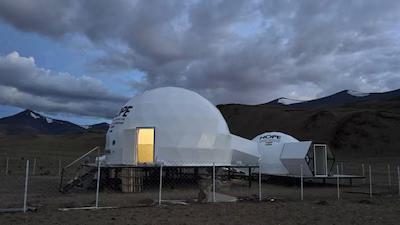
ISRO Sets Up Station in Ladakh to Simulate Life on Moon & Mars
In a groundbreaking move, the Indian Space Research Organisation (ISRO) has set up the Himalayan Outpost for Planetary Exploration (HOPE) in Ladakh’s Tso Kar Valley. This historic station is designed to simulate life on the Moon and Mars, and it’s all set to test life-support systems for ISRO’s future lunar and Martian missions. The Tso Kar Valley was chosen for its unique environment, which is eerily similar to that of Mars. With extreme cold, low atmospheric pressure, saline permafrost, and high UV radiation, this valley is the perfect setting to test the feasibility of human habitation on the Red Planet.
For 10 days, starting from August 1, two crew members will undertake various tests at the HOPE facility. These tests will focus on evaluating the performance of life-support systems, including air, water, and food supplies, as well as the crew’s ability to work efficiently in extreme conditions. The goal is to identify any challenges or limitations that may arise during future missions to the Moon and Mars.
So, what makes the Tso Kar Valley so special? For starters, its high altitude of 15,000 feet above sea level means that the air pressure is significantly lower than at sea level. This is similar to the conditions on Mars, where the atmospheric pressure is about 1% of that on Earth. The valley’s extreme cold, with temperatures often dipping below -20°C, is another crucial factor. This is comparable to the temperatures that astronauts can expect to encounter during a Martian winter.
Another key aspect of the Tso Kar Valley’s environment is its high UV radiation. This is a major concern for any mission to Mars, as the Martian surface receives about 50% more UV radiation than the Earth’s surface. The HOPE facility will test the effectiveness of various UV-blocking materials and technologies to ensure the safety of astronauts during their Martian sojourn.
The valley’s saline permafrost is also an important factor in the simulation. Permafrost is a common feature of Martian soil, and understanding how to work with it is crucial for any mission to the Red Planet. The HOPE facility will test various methods for extracting water from the permafrost, as well as the best ways to store and transport it.
The HOPE facility is designed to resemble a mini-Mars habitat, with inflatable modules and a range of scientific instruments. The modules are equipped with advanced life-support systems, including air and water recycling facilities, as well as specialized equipment for conducting scientific experiments.
The crew members who will be undertaking the 10-day simulation are experienced astronauts, handpicked by ISRO for their skills and expertise. They will be working in shifts, with each shift lasting around 12 hours. During this time, they will be conducting a range of tests, including scientific experiments, equipment checks, and simulated spacewalks.
The success of the HOPE mission is crucial for ISRO’s future plans to explore the Moon and Mars. The organization has already announced plans to send a manned mission to the Moon by 2024, and the HOPE facility will play a key role in preparing for this mission.
The HOPE mission is a testament to ISRO’s commitment to space exploration and its determination to push the boundaries of human knowledge. As we continue to explore the vast expanse of space, it’s essential that we simulate the conditions we’ll encounter on other planets and moons. The HOPE facility is a major step in this direction, and we can’t wait to see what the future holds for ISRO’s lunar and Martian missions.






